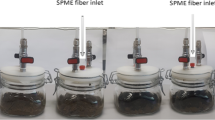Abstract
A series of batch tests using tire powder were performed to investigate the volatile organic compound (VOC) sorption behavior, and to evaluate the effect of surrounding conditions on the VOC sorption onto tire powder. Benzene, TCE, PCE, and ethylbenzene were selected as target VOCs. Sorption of VOCs onto tire powder was well explained by a linear (partitioning type) model. Target VOCs did not seem to compete with other VOCs significantly when sorbed onto tire powder for the range of concentrations tested. However, sorption of benzene was slightly suppressed in the presence of ethylbenzene. Solid effect was observed in sorption of benzene, TCE, and PCE. Tire-water partition coefficients of these VOCs decreased with increasing sorbent dosage and solid effect disappeared when sorbent dosage increased sufficiently. An appropriate tire powder dosage (≥10 g/L) should be used to preclude solid effect in measuring tire-water partition coefficients of VOCs. The effects of background conditions, such as temperature, pH, and ionic strength did not seem to be significant. Tire-water partition coefficients of VOCs, not tested in this study, could be estimated using a good logarithmic relationship between observed partition coefficients and octanol-water partition coefficients of VOCs tested.
Similar content being viewed by others
References
Chiou C.T., Peters L.J. and Freed V.H. (1979). A physical concept of soil-water equilibria for non-ionic organic compounds.Science, 206(4420), 831–832.
Chiou C.T., Porter P.E. and Schmedding D.W. (1983). Partition equilibria of nonionic organic compounds between soil organic matter and water.Environmental Science and Technology, 17(4), 227–231.
Dewulf J., Drijvers D. and Van Langenhove H. (1995). Measurement of Henrys law constant as function of temperature and salinity for the low temperature range.Atmospheric Environment, 29, 323–331.
Dodds, J., Domenico, W.F., Evans, D.R., Fish, L.W., Lassahn, P.L., and Toth, W.J. (1983). Scrap tires; a resource and technology evaluation of tire pyrolysis and other selected alternatives technologies, Prepared for the U.S. Department of Energy Report, EGG-244, Prepared by EG&G Idaho, Inc., Idaho Falls, ID.
Gschwend P.M. and Shian-chee Wu (1985). On the constancy of sediment-water partition coefficients of hydrophobic organic pollutants.Environmental Science and Technology, 19(1), 90–96.
Jang, J.W., Yoo, T.S., Oh, J.H., and Iwao Iwasaki (1998). Discarded tire recycling pratices in the United States, Japan and Korea,Resources, Conservation and Recycling, 22, 1–14.
Joo, J.C., Kim, J.Y. and Nam, K. (2001). “Mathematical modeling of organic chemical permeation through flexible membrane liners,”Proceedings Sardinia 2001, 8th Waste Manage-ment and Landfill Symposium, Vol. 3, Oct. 1–5, Sardinia, Italy, 237–244.
Karickoff S.W., Brown D.S., and Scott T.A. (1979). “Sorption of hydrophobic pollutants on natural sediments.”Water Research, 13(3), 241–248.
Kim, J.Y., Park, J.K., and Edil, T.B. (1997). “Mitigation of Organic Compounds in the Aqueous Phase onto Tire Rubber,”Water Environment Research, 68(1), 4–10.
Ministry of Environment,Environmental Statistics Yearbook, Korea, 2000.
Oh, D.I. and Kim, J.Y. (1999). “Partitioning of volatile organic compounds between tire powder and water,”Proceedings of the 10 th Annual Research of Conference of the Japan Society of Waste Management Experts (3), Oct. 26–28, Omiya, Japan, 25–27.
Park, J.K. and Nibras, M. (1993). Mass flux of organic chemicals through high density polyethylene,Water Environment Research, 65(3), 227–237.
Park, J.K., Kim, J.Y., Madsen, C.D., and Edil, T.B. (1997). Retardation of volatile organic compound movement by a soil-bentonite slurry cutoff wall amended with ground tire,Water Environment Research, 69(5): 1022–1031.
Rickabaugh J.F. and Kinman R.N. (1993). “Evaluation of trace VOC emissions from sanitary landfills,”Journal of Environmental Engineering, 119(4), 645–657.
Schwarzenbach R.P., Gschwend P.M. and Imboden D.M., (1993).Environmental Organic Chemistry, Wiley and Sons, New York, NY, USA, 681 p.
Tchobanoglous G., Theisen H., and Vigil S. (1993).Integrated Solid Waste Management, MacGraw-Hill, Inc., New York, NY, USA, 394 p.
Voice T.C. and Weber W.J. Jr. (1985). Sorbent concentration effects in liquid/solid partitioning,Environmental Science and Technology, 19(9), 789–796.
Weast R.C. (1975).Handbook of Chemistry and Physics. A Ready Reference Book of Chemical and Physical Data CRC press, Cleveland, OH, USA, 2351 p.
Xing, B., Pignatello, J.J. and Gigliotti, B. (1996). Competitive sorption between atrazine and other organic compounds in soils and model sorbents.Environmental Science Technology, 30(8), 2432–2440.
Author information
Authors and Affiliations
Corresponding author
Additional information
The manuscript for this paper was submitted for review on January 4, 2002.
Rights and permissions
About this article
Cite this article
Oh, D.I., Nam, K. & Kim, J.Y. Applicability of tire powder for the control of volatile organic compound emission in solid waste landfills. KSCE J Civ Eng 6, 89–95 (2002). https://doi.org/10.1007/BF02829128
Issue Date:
DOI: https://doi.org/10.1007/BF02829128




